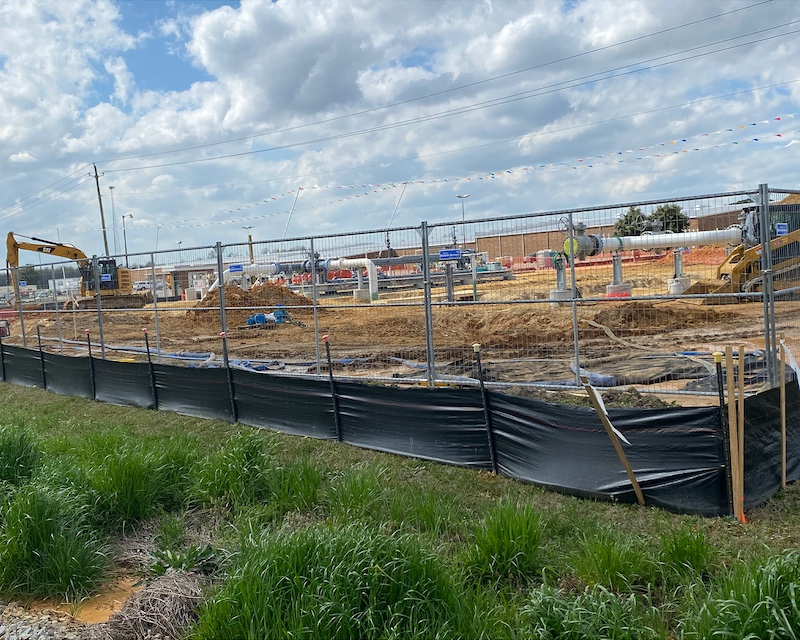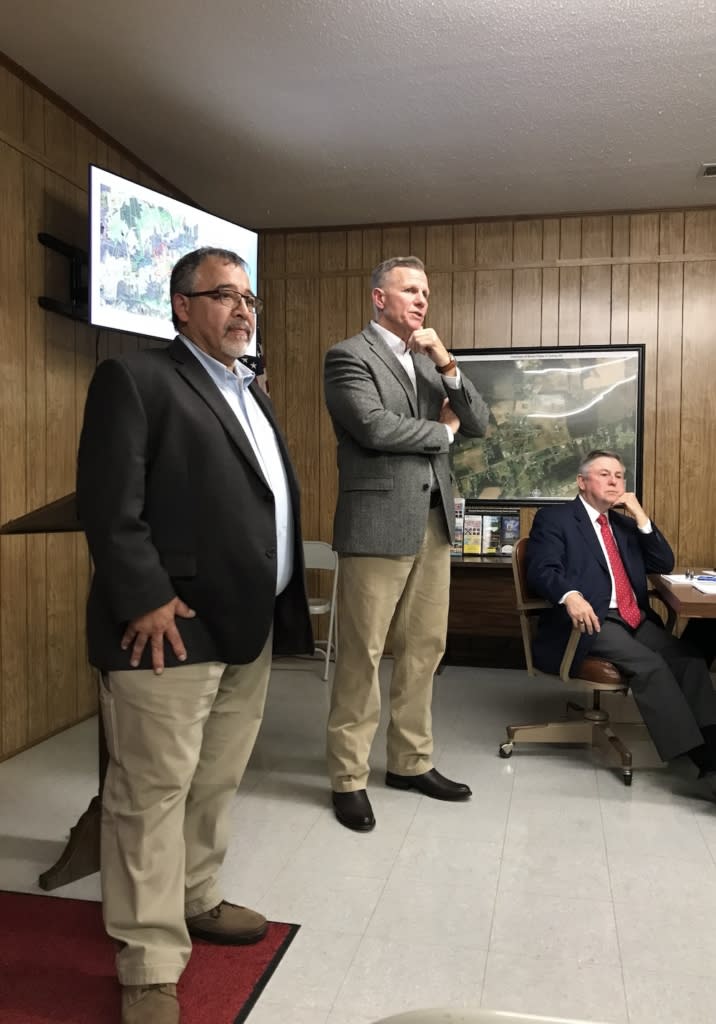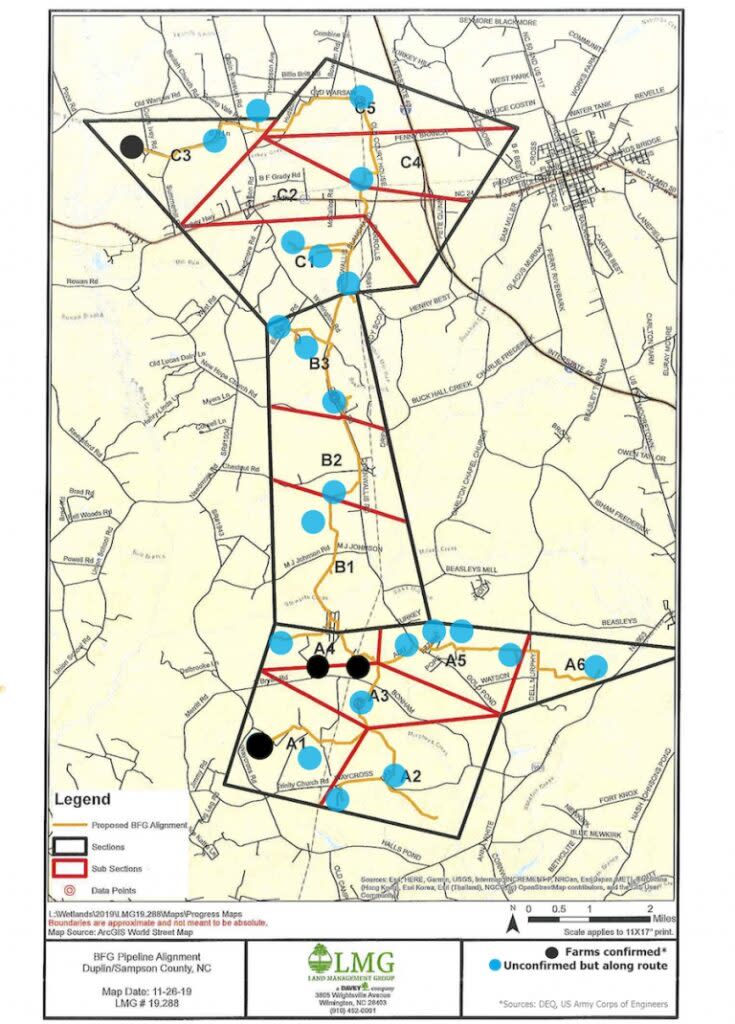High costs, interconnection obstacles killed a swine gas-to-electricity venture in Sampson County

Piedmont is upgrading a natural gas pipeline system in front of the ZNC facility in Turkey, in Sampson County. It is independent of the ZNC project, but the company has granted a permanent easement on its property for a pipeline maintenance station. (Photo: Lisa Sorg)
Martin Redeker and Joe Carroll spent more than five years toiling in a windowless steel barn in Duplin County, perfecting a low- to no-emissions technology they said would transform how hog waste could be used to generate electricity.
Such was the faith in the project that Montauk Renewables, a publicly traded company based in Pittsburgh, bought the company and brought Redeker and Carroll onboard. And last year, the new subsidiary, ZNC Turkey Creek, signed a Power Purchase Agreement with Duke Energy that would have helped the utility provide a portion of its electricity derived from swine waste, as legally required.
Now the interconnection project is dead after ZNC learned it could cost as much as $100 million and take at least eight years to tie into the Duke Energy grid, N.C. Utilities Commission documents show.
And unless the commission approves ZNC’s amended proposal, the company says it will have to absorb millions of dollars in losses and potentially cancel other aspects of the venture altogether.
An “expensive and convoluted process”
Commission filings detail the obstacles ZNC faced in trying to connect to the electric grid. And for alternative energy sources – the fledgling swine and poultry waste sectors, but especially solar, battery storage and wind – these challenges and delays are typical and getting worse.
“This expensive and convoluted process of attempting to connect to the grid is happening in North Carolina – and everywhere,” said Nancy LaPlaca, an energy policy consultant for Third Act, which engages older Americans in climate action, elections and democracy. “Nationwide, there is double the entire electric capacity of the U.S. sitting in active interconnection queues.”
Last year, ZNC dismantled its reactor – a labyrinth of pipes and catwalks and chambers – and moved it from Duplin County to a 500,000-square-foot former warehouse along Highway 24 in Turkey, in Sampson County.
From there, ZNC planned to truck in swine waste – totaling tens of thousands of tons each year – from lagoons at area farms. The waste would then be fed into an oxygen-free chamber, where it would be subjected to extremely high temperatures – a process known as pyrolysis – until it became biogas.
The gas would then be fed to microturbines and converted to electricity to sell to Duke Energy, which would also purchase renewable energy credits from ZNC.
ZNC estimated that when its plant became fully operational, it would generate enough energy to power more than 5,000 homes and businesses.
This method, company vice president Redeker previously told Newsline, would reduce the amount of waste accumulating in the lagoons, and in turn reduce the odors plaguing neighbors of the farms. It could even be more climate-friendly: Since the waste would be removed more often, there would be less time for methane to escape from the lagoons. And since the biogas would be produced in a “closed-loop” system, there would be little, if any air emissions, Redeker said.
(Diesel trucks that would have transported the waste would still emit greenhouse gases. Critics of swine gas production note that even this type of waste removal still entrenches the outdated lagoon-and-sprayfield model of concentrated animal feeding operations.)
As part of its confidential Power Purchase Agreement with Duke, ZNC submitted the required interconnection request last summer. This is routine: Companies that want to connect their projects to the grid must undergo a series of studies before they can be built. The studies establish the potential grid system upgrades and estimate and assign the costs to do so.
Even before entering the interconnection queue, companies can use maps, data and request information from the utility to get an initial sense of whether the project is feasible, Duke spokesman Jeff Brooks said.
But that doesn’t tell the full story, Carroll said. “The utility will only provide very limited information in response to those requests.”
By last fall, Duke had provided a Phase I report to ZNC, “which identified several obstacles that will render interconnection infeasible,” ZNC attorneys wrote to the Commission.
For starters, the cost of interconnection facilities and network upgrades would total $13.5 million, not including the costs of acquiring easements, and Duke “was unable to provide estimates of such costs,” the letter read.
Undeterred, ZNC hired additional engineers and land-use consultants for a second study phase. The results were even more dispiriting: ZNC would also have to spend another $80 million to $100 million over the next 15 years to construct, own, maintain and insure five miles of new conductors. Plus, the company would need broker agreements with dozens of private property owners for new rights-of-way.
Even if all those steps went smoothly, Duke would not begin to build the grid interconnection until the ZNC had acquired all of the rights-of-way and completely installed privately owned poles and power lines. That work would postpone the estimated interconnection date by eight years.
Brooks, the Duke spokesman, said the interconnection process has improved since 2021, when the commission approved changes suggested by the utility. The changes also complied with Federal Energy Regulatory Commission rules.
Regardless of the type of energy they produce, companies that want to sell power to the Duke grid must go through a “first-ready, first-served cluster process” to determine whether they can meet the utility’s interconnection requirements. The upgrade costs also are shared across projects.
This is a change from the previous system – a “first-come, first-served serial process” – which enabled “speculative and non-ready” interconnection customers to idle while blocking viable projects from coming online, Brooks said.
There were other inequities in the original process, as well. All of the interconnection costs were borne by the earliest projects because they triggered the need for system upgrades. The latecomers benefited from those upgrades without having to pay for them.
An alternative regulatory model
There is a different interconnection philosophy, one that is used in most of Texas, where ERCOT operates the grid, and in many parts of Europe, said Shelley Robbins, senior decarbonization manager with the Southern Alliance for Clean Energy. “That’s to basically interconnect most everything, but subject all resources to curtailment,” meaning energy producers have to adjust their outputs in order to keep the grid balanced.
Since Duke has a near-monopoly in North Carolina, ZNC has no other buyers for its electricity.
“Duke is indeed holding all of the cards, but because we don’t have a separate transmission operator here, Duke is responsible for the grid itself, and that includes reliability,” Robbins said.
The ability to connect to the grid without constraining its function depends on location and existing infrastructure. “Some parts of the Duke grid are constrained and don’t have the infrastructure to safely pick up the generated electricity,” Robbins said, which makes interconnection expensive because of the necessary upgrades.
In North Carolina, nearly 13,000 megawatts of energy capacity are idling in the interconnection queue, according to a report issued last month by the Lawrence Berkeley National Laboratory. Solar and battery storage account for 92% of that capacity, followed by natural gas, wind and “other” — defined as biofuels, landfill gas, geothermal and hydropower.
Nationwide, interconnection wait times are also on the rise, according to the Berkeley Laboratory report. The typical time from connection request to commercial operation increased from less than two years for projects built from 2000 to 2007 to a median of five years for projects built in 2023.
“There are a myriad of ways that the process could be improved from the customer or developer perspective,” Carroll said. “But only Duke has full visibility into all of the legal regulatory, electrical and infrastructure constraints to be considered.”
The behemoth Align RNG wants to expand its network to another 35 farms
North Carolina’s major swine gas producer, Align RNG, is a partnership between Smithfield Foods and Dominion Energy. The first phase of project construction is nearly complete, and will allow 19 farms, outfitted with anaerobic digesters, in Duplin and Sampson counties to send swine gas through 30 miles of low-pressure pipeline. That gas will arrive at Align’s upgrading facility near the Duplin-Sampson county line – less than five miles from ZNC. Once the swine gas is cleaned, Align will transmit it through a main pipeline owned by Piedmont Natural Gas, a subsidiary of Duke Energy.
Align now has asked the Utilities Commission to approve a second phase. This would entail 35 new farms in Duplin County producing swine gas, with another 50 miles of pipeline. However, the gas would be processed at smaller upgrading facilities at the farms, rather than at Align’s centralized facility.
The Utilities Commission has yet to issue an order approving the updated plan, but the Public Staff, which represents the ratepayers, had no objection.
Align has refused to make public, including to the Department of Environmental Quality, the locations of 15 of the 19 participating farms or the pipeline routes. The four farms whose locations have been disclosed are corporately owned by Smithfield.
Newsline previously reported that the U.S. Army Corps of Engineers, which is surveying pipeline routes for potential wetlands and streams, would not disclose the information, ostensibly for homeland security reasons.
Trying to keep the project alive
In early March, ZNC asked the Utilities Commission to approve its amended plan for generating and using biogas. The company had already planned to convert some of the swine waste and combine it with switchgrass to create biochar and fertilizer, which it could then sell to farms.
Under the amendment, the swine gas would still be converted into electricity, but instead of selling the power to Duke, ZNC would use it to power its own operations – known as “self-provisioning.”
If approved, ZNC’s initial operation would be delayed about nine months, until the third quarter of this year. The plant wouldn’t be fully operational until the late summer or early fall of 2025.
Carroll said ZNC could also produce pipeline-quality swine gas to inject into the Piedmont line, which will interconnect at ZNC’s facility. Piedmont is a subsidiary of Duke Energy.
However, gas generated from swine and poultry waste and landfills contains impurities that must be removed before being injected into pipelines.
“Not all of our swine-derived biogas was designed to meet pipeline specifications for injection,” Carroll said.
Meanwhile, Duke has struggled to provide a percentage of its power – 0.07% of the previous year’s retail sales – from swine waste, as required by the state’s Renewable Energy Portfolio Standard.
Those requirements went into effect in 2012, but since then, the Utilities Commission has delayed compliance deadlines and adjusted percentages for Duke, Dominion and electric co-ops several times.
The utilities have cited the “lack of technological progress” for power production from swine waste, according to commission documents, and those projects continue to experience operational difficulties.”
Brooks said Duke has met its modified swine waste energy targets. However, to hit those goals, Duke purchases some of its swine waste-derived energy from out-of-state. The sellers and amount of swine gas purchased is confidential, Brooks said.
Just last week, ZNC informed the Public Staff that it is considering further amending its application, according to commission documents. Details of the new amendment have not yet been disclosed.
And there is still public opposition to the facility. At a town meeting in 2022, residents peppered Redeker and Carroll with questions about potential odor and truck traffic.
Donnie Myers is the former mayor of Turkey, who served from 1975-1979 and again from 2015-2019. He lives due east of the ZNC plant. “Will there be leaks? Accidents?” Myers said, in a recent interview with Newsline. More than a decade ago, the town passed an ordinance prohibiting hog farms from being built within a mile of the Turkey limits. “I never imagined they’d bring the manure to us,” Myers said.
The post High costs, interconnection obstacles killed a swine gas-to-electricity venture in Sampson County appeared first on NC Newsline.



